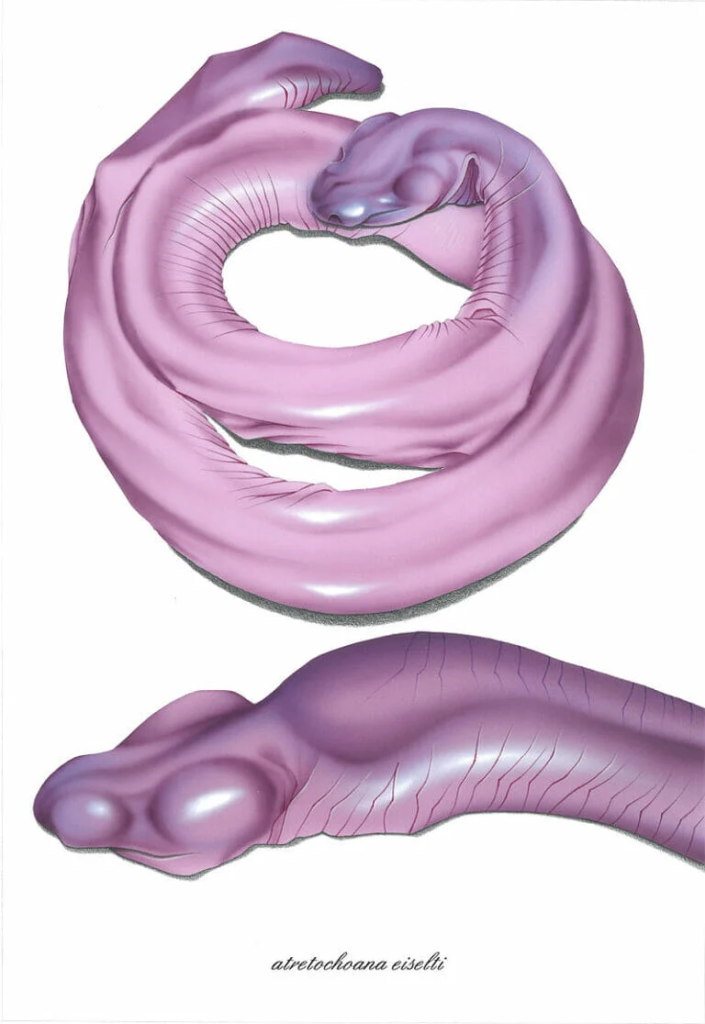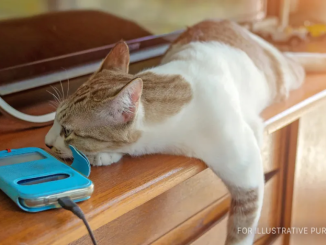
The animal world is full of surprises, with some creatures being more eye-catching than others because of their strange looks or unusual nature.
When I first saw a picture of this weird “penis snake,” I thought it was a joke. But, to my surprise, it turned out to be a real animal. So, let’s dive into the story behind the viral image that has left thousands of people in shock.
Throughout history, anything shaped like a phallus has grabbed attention and sparked curiosity. A few years ago, images of a strange-looking creature started making the rounds online, leaving many people scratching their heads in disbelief.
With its unique appearance, this mysterious animal quickly earned nicknames like the “penis snake,” “blind snake,” or the “man-aconda.”
But no, it’s not what you think.
Even though it looks a lot like a snake, this creature is actually called *Atretochoana eiselti*. It’s not a snake at all, but an amphibian, more closely related to a salamander. It’s also the largest known lungless tetrapod, which means it breathes through its skin instead of lungs.
This rare animal lives in the waters of the Amazon in Brazil and was hard to find for a long time. It was first discovered by Sir Graham Hales during an expedition with Sir Brian Doll in the late 1800s.
However, it wasn’t officially described until 1968. After more research, scientists reclassified it in 1996, giving it its own unique genus, *Atretochoana*.
In 2011, this species was rediscovered in the Amazon region. It lives only in the Amazon River and its largest tributary, the Madeira River in Brazil. The “penis snake” has only been found in this area and nowhere else in the world.
The viral pictures that blew up the internet a few years ago actually came from 2011. That’s when a whole family of these phallic-shaped creatures was found at the bottom of the Madeira River in Brazil. They were discovered when the river was drained during work on a hydroelectric dam.
Julian Tupan, a biologist working with the Santo Antonio Energy company on the dam, explained that not much is known about these lungless, limbless amphibians.
“Out of the six we collected, one died, three were released back into the wild, and two were kept for study,” he told *Estadao*, according to the U.K.’s *The Sun*.
Tupan pointed out that these “snakes” aren’t dangerous and are unlikely to show any aggressive behavior.
“Even though they look like snakes, they’re not reptiles; they’re more closely related to salamanders and frogs. We think the animal breathes through its skin and probably eats small fish and worms, but that hasn’t been proven yet.
“The Amazon is full of surprises when it comes to reptiles and amphibians. There’s still a lot more to discover.”
According to a paper published in the Brazilian scientific journal *Boletim do Museu Paraense Emílio Goeldi: Ciências Naturais*, one of these creatures found in the riverbed was photographed extensively. Some of the animals were released back into the Madeira River, while others were sent to the Emilio Goeldi Paraense Museum in Belem, Brazil.
The most popular photo, which Julian Tupan shared on Instagram, shows an adult female *A. eiselti* that’s just under 40 inches long.
Even though these creatures are fascinating, there’s still a lot we don’t know about them. One mystery that puzzles researchers is their diet. Scientists think these phallic-shaped animals might eat small fish, worms, and other aquatic invertebrates, but more research is needed to confirm this.

Another mystery about these creatures is how they breathe, as scientists haven’t confirmed the method yet. When the six specimens were discovered in 2011, it made things even more puzzling. What’s especially interesting is where they were found— in cold, fast-flowing water with limited oxygen. Since warmer water holds less oxygen, their ability to live without lungs is even more remarkable.
Based on these findings, scientists believe this species might be widespread across the Brazilian Amazon and could even extend into Bolivia.
Nature constantly surprises us with its endless wonders. From the deepest oceans to the tallest mountains, the natural world is full of amazing things waiting to be discovered.
Share this incredible story on Facebook with your friends and family to spark their curiosity and get them talking about the wonders of nature!
“When you have a broken heart – at least when I do – you got to get it out of your system. You want people to sympathize with you. I was at rock bottom, in the middle of hell.”

Rumors of a breakdown dogged Blake Shelton and Miranda Lambert’s brief marriage. Both are now contentedly wed to separate partners.
Given their prominent positions in the music industry, it is understandable why Blake Shelton and Miranda Lambert fell in love so soon.
Even though he was still married when he met her, their shared love of music drew them together. Their love affair ended in divorce eventually.

Following their introductions at CMT’s 100 Greatest Duets Concert, the two musicians first came into contact with one another in 2005.
From the beginning, she was drawn to him, but he ignored her because he was married. In a similar vein, Shelton was instantly smitten with the “Drunk” singer.
The beginning of their romantic tale
In a subsequent interview, Lambert claimed to have seen Shelton’s wedding photo in Country Weekly and to have known he was married. She continued, saying:
“I should have known better—this is forbidden. For crying out loud, my folks work as private detectives. I’ve witnessed affairs my entire life. I am one of the few who can truly know better than this.
Even still, she was powerless to ignore the “inevitable chemistry” they shared from the start. Shelton separated from his wife Kaynette Williams a year later and went after Lambert.
Shelton asked Lambert to marry him in 2010, but he did so in remembrance of her father. The “God’s Country” singer gave Lambert’s father a call to get his OK before proposing on May 9 and bringing out a platinum and diamond ring that he had personally picked out.
“It’s so much more perfect than I could have picked myself, but we’ve been together for five years, so he knew exactly what I wanted,” Lambert remarked. The country music artist cherished the casual party that was the proposal.
Apart from that specific instance, 2010 was an exceptional year for Lambert, as she achieved her first number one song, “White Liar,” in January and won both Album of the Year and Top Female Vocalist at the ACM Awards.

The pair married in 2011, but problems soon arose in their union. Rumors of a breakup surfaced in 2013, which the couple refuted.
In order to demonstrate that there were no secrets in their marriage, the “The Voice” judge at the time said that his wife had access to his phone anytime she wanted. He declared:
We truly do have that level of trust. Nothing is hidden. “Go search through my drawers or my computer if you feel like it,” is what I’ll say, and it’s been extremely helpful since I don’t want her to ever question anything.
Even though there were still rumors in 2014, the pair didn’t seem to be affected and even made jokes about the supposed divorce. In the past two years, Lambert joked, “I think I’ve had like five sets of twins and we’ve been divorced four times, and one of us had a $100 million divorce.”
Shelton and Stefani were married in a modest chapel on the “Home” singer’s property in July 2021 in a private ceremony held in Oklahoma.
The pair sent heartfelt wishes on social media to commemorate their third wedding anniversary the same year.

Lambert acknowledged that marriage was difficult, but he also stated it was a wonderful gift that shouldn’t be taken too seriously. She continued, saying:
It is our constant goal to be together. On our anniversary, I wouldn’t want to be on the other side of the nation! That moment is precious.
However, the pair soon shown that there was turmoil in paradise, proving the claims to be real. Gwen Stefani collaborated with Shelton as a coach on season nine of “The Voice” in April 2014.
After four years together, Shelton and Lambert announced their divorce within a year. They said in a statement that was released:
We are actual individuals with actual lives, families, friends, and coworkers. As a result, we respectfully request your understanding and privacy in this very private situation.
The couple disclosed that they were surprised by the split and that they had to take a risk by choosing to continue living their lives on their own.
Both before and after the publishing of the statement, Shelton and Lambert said nothing about the matter. They had ten wonderful years together, including their courtship phase.
LIFE AFTER PARTNERSHIP
Shelton quickly started dating Gwen Stefani, his co-star on “The Voice,” following their breakup. On November 4, 2015, they made their relationship official via Shelton’s agent, who stated:
“Gwen and Blake have been friends for a long time, but they recently started dating.”

The couple claimed that their congruent divorces and life events strengthened their bond.
Shelton eventually told Lambert about his divorce in 2020. Details regarding their breakup were disclosed in his song “If I’m Honest.”
He answered, “Maybe not specifics.” However, you get the gist of it. It is my chronicle of divorce, but perhaps even more than that, it is also my record of happiness and infatuation.
He’s got to admit that his second divorce has devastated him to the point of no return. Even though Shelton did not create the song “She’s Got a Way With Words,” which describes a partner who strayed and lied, he isn’t stopping people from believing it was a reflection of his own relationship. He declared:
“You have to let go of it when you’re feeling down, or at least that’s how I feel. You want to be able to relate to other individuals. I was in the midst of hell, at my lowest point.
But there was also someone who understood him quite well. It was a day he will never forget. “Gwen, who I didn’t really know, had these enormous tears in her eyes when I looked at her. It struck me, “Wow, she really feels bad for me.”

The singer of “Candyman” had recently filed for divorce from Gavin Rossdale, her husband of 20 years. Later, she spoke with Shelton by herself, and that’s when their close relationship began.
As time went on, their friendship grew; they went from communicating their understanding to exchanging emails once a week. He declared:
“Then I wake up, and she’s my entire world, and I wonder if she feels the same way about me.”
Shelton and Stefani were married in a modest chapel on the “Home” singer’s property in July 2021 in a private ceremony held in Oklahoma. Luckily, Stefani’s family and kids adore her new husband and have a wonderful impact on her. Says she:
“I’ve never had a more feminine style. I think it’s because I have a pretty macho man and I’m genuinely in love. Now that I’ve let that side of myself show, I enjoy it.
Within three months of their first date, Lambert also wed Brendan McLoughlin, an officer in New York City. Even though he was married when they initially met, their love remained. It was made public in 2022 that the couple was attempting to conceive.



Leave a Reply